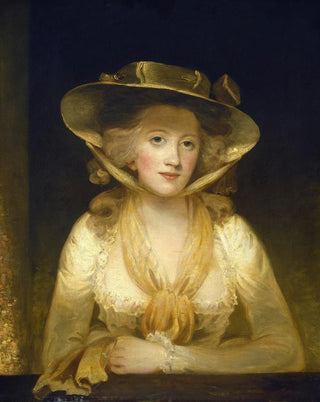Art print | Dame Cunliffe - John Hoppner


View from behind

Frame (optional)
In the fascinating world of art, some works manage to capture the very essence of humanity, transcending time and space. "Dame Cunliffe - John Hoppner" is one of those creations that, through its elegance and depth, invites prolonged contemplation. This painting, depicting a woman of undeniable grace, is much more than a simple portrait; it reflects an era, a society, and an aesthetic ideal. The art print of this piece allows for rediscovering not only the beauty of its subject but also the finesse of Hoppner's talent, whose brushstrokes evoke a rare intimacy between the artist and his model.
Style and uniqueness of the work
John Hoppner's work stands out for its unique approach to portraiture, blending realism and idealization. In "Dame Cunliffe," every detail is carefully crafted, from the textures of the clothing to the subtle expressions on the face. Hoppner excels in the use of light and shadow, creating an atmosphere that feels almost tangible. The lady's pose, both natural and posed, evokes a dignity and sophistication that captivate the viewer. The chosen colors, soft and harmonious, add an almost dreamlike dimension to the scene, reinforcing the idea that beauty can be a form of art in its own right. This portrait does not merely depict a person; it tells a story, that of a woman rooted in her time, yet whose aura transcends the limits of her era.
The artist and his influence
John Hoppner, a British painter of the 18th century, left his mark on his era with his distinctive style and his ability to portray his contemporaries with rare sensitivity. Trained at the school of the great masters, he developed a technique that combines finesse and power. His portraits, often compared to those of his rival Joshua Reynolds, are distinguished by a more intimate approach, highlighting the emotions and personality of his subjects. Hoppner also played an important role in the evolution of British portraiture, helping to establish aesthetic standards that would endure beyond his career. His influence is felt not only within artistic circles

Matte finish

View from behind

Frame (optional)
In the fascinating world of art, some works manage to capture the very essence of humanity, transcending time and space. "Dame Cunliffe - John Hoppner" is one of those creations that, through its elegance and depth, invites prolonged contemplation. This painting, depicting a woman of undeniable grace, is much more than a simple portrait; it reflects an era, a society, and an aesthetic ideal. The art print of this piece allows for rediscovering not only the beauty of its subject but also the finesse of Hoppner's talent, whose brushstrokes evoke a rare intimacy between the artist and his model.
Style and uniqueness of the work
John Hoppner's work stands out for its unique approach to portraiture, blending realism and idealization. In "Dame Cunliffe," every detail is carefully crafted, from the textures of the clothing to the subtle expressions on the face. Hoppner excels in the use of light and shadow, creating an atmosphere that feels almost tangible. The lady's pose, both natural and posed, evokes a dignity and sophistication that captivate the viewer. The chosen colors, soft and harmonious, add an almost dreamlike dimension to the scene, reinforcing the idea that beauty can be a form of art in its own right. This portrait does not merely depict a person; it tells a story, that of a woman rooted in her time, yet whose aura transcends the limits of her era.
The artist and his influence
John Hoppner, a British painter of the 18th century, left his mark on his era with his distinctive style and his ability to portray his contemporaries with rare sensitivity. Trained at the school of the great masters, he developed a technique that combines finesse and power. His portraits, often compared to those of his rival Joshua Reynolds, are distinguished by a more intimate approach, highlighting the emotions and personality of his subjects. Hoppner also played an important role in the evolution of British portraiture, helping to establish aesthetic standards that would endure beyond his career. His influence is felt not only within artistic circles






